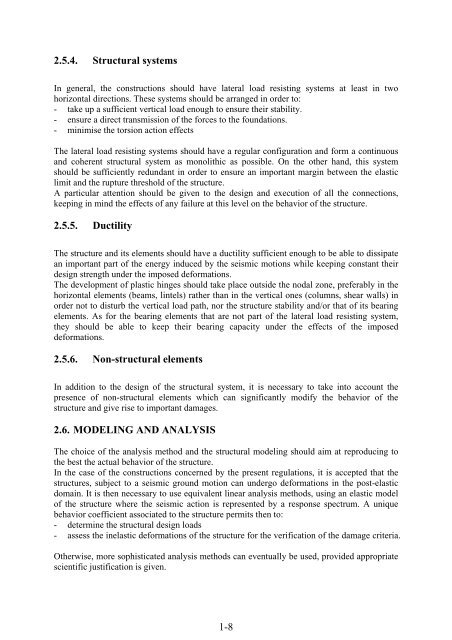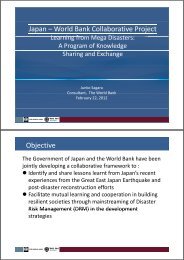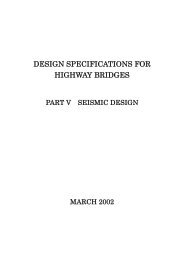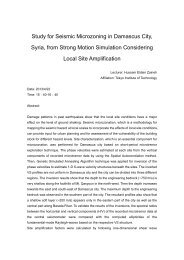algerian earthquake resistant regulations « rpa 99 - IISEE
algerian earthquake resistant regulations « rpa 99 - IISEE
algerian earthquake resistant regulations « rpa 99 - IISEE
Create successful ePaper yourself
Turn your PDF publications into a flip-book with our unique Google optimized e-Paper software.
2.5.4. Structural systems<br />
In general, the constructions should have lateral load resisting systems at least in two<br />
horizontal directions. These systems should be arranged in order to:<br />
- take up a sufficient vertical load enough to ensure their stability.<br />
- ensure a direct transmission of the forces to the foundations.<br />
- minimise the torsion action effects<br />
The lateral load resisting systems should have a regular configuration and form a continuous<br />
and coherent structural system as monolithic as possible. On the other hand, this system<br />
should be sufficiently redundant in order to ensure an important margin between the elastic<br />
limit and the rupture threshold of the structure.<br />
A particular attention should be given to the design and execution of all the connections,<br />
keeping in mind the effects of any failure at this level on the behavior of the structure.<br />
2.5.5. Ductility<br />
The structure and its elements should have a ductility sufficient enough to be able to dissipate<br />
an important part of the energy induced by the seismic motions while keeping constant their<br />
design strength under the imposed deformations.<br />
The development of plastic hinges should take place outside the nodal zone, preferably in the<br />
horizontal elements (beams, lintels) rather than in the vertical ones (columns, shear walls) in<br />
order not to disturb the vertical load path, nor the structure stability and/or that of its bearing<br />
elements. As for the bearing elements that are not part of the lateral load resisting system,<br />
they should be able to keep their bearing capacity under the effects of the imposed<br />
deformations.<br />
2.5.6. Non-structural elements<br />
In addition to the design of the structural system, it is necessary to take into account the<br />
presence of non-structural elements which can significantly modify the behavior of the<br />
structure and give rise to important damages.<br />
2.6. MODELING AND ANALYSIS<br />
The choice of the analysis method and the structural modeling should aim at reproducing to<br />
the best the actual behavior of the structure.<br />
In the case of the constructions concerned by the present <strong>regulations</strong>, it is accepted that the<br />
structures, subject to a seismic ground motion can undergo deformations in the post-elastic<br />
domain. It is then necessary to use equivalent linear analysis methods, using an elastic model<br />
of the structure where the seismic action is represented by a response spectrum. A unique<br />
behavior coefficient associated to the structure permits then to:<br />
- determine the structural design loads<br />
- assess the inelastic deformations of the structure for the verification of the damage criteria.<br />
Otherwise, more sophisticated analysis methods can eventually be used, provided appropriate<br />
scientific justification is given.<br />
1-8








